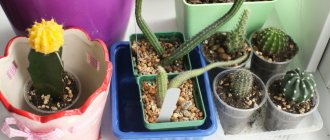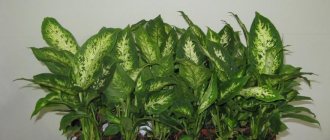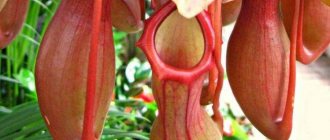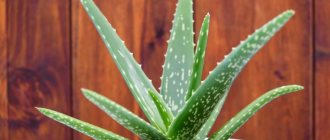- October 29, 2018
- Houseplants
- Natalia Miroshnikova
Croton, or, as it is also called, codiaum, is a perennial shrub of the Euphorbiaceae family. It is valued by gardeners for its unpretentious character and attractive appearance, which is given to it by large, variegated leaves. A description and photo of a croton flower, how to care for and propagate the plant - you will find this and much more in our material.
Description
Croton (codium) is a perennial, decorative deciduous shrub of the Euphorbiaceae family. In its natural environment it can be found on the islands of the Pacific Ocean. And also in Northern Australia and Southeast Asia. The genus of crotons, according to various sources, contains from 17 to 1200 species, but only the variegated variety and its hybrids are grown at home.
Croton flower is a low shrub with large, leathery leaves. Depending on the variety, the plates are oblong-lanceolate, asymmetrical, or broadly ovoid in shape. Their tips can be pointed or blunt.
Young croton leaves are colored in light yellowish-green shades. But over time, they acquire a bright color and can be either dark green or red-burgundy. Moreover, regardless of the variety, there are bright veins or spots on the leaves.
Croton flowers have no aesthetic value. After all, small, inconspicuous buds, painted in cream shades, do not add attractiveness to the plant. In addition, they draw juices from the culture. Therefore, it is recommended to cut them out immediately, of course, if you are not going to propagate the plant by seed.
It is worth considering that croton is a poisonous flower. Its milky sap causes nausea, vomiting, stomach upset and contact dermatitis. Therefore, you need to wear gloves when caring for the plant. In addition, it is important to keep the flower pot out of the reach of children and pets.
3.Types of croton:
3.1.Croton Tamara Branch
Bright ornamental bushes up to 1.5 m high with erect, weakly branching stems, densely leafy oblong, lanceolate, hard leaves with large white and green spots.
↑ Up,
3.2.Croton Excelent
Spectacular variegated plants with oblong, three-lobed leaves, colored emerald green. A distinctive feature of the variety is the presence of yellow, pinkish or red stripes on the leaf blades, located mainly along the leaf veins.
↑ Up,
3.3.Mrs. Iceton's Codeium
Variegated plants with strong, erect, unbranched stems bearing bright, variegated leaves of a wide variety of shades. The leaf blades are glossy, hard, lanceolate. Unlike other crotons, this variety retains foliage along the entire length of the trunk and does not expose its lower part.
↑ Up,
3.4. Croton Mammi - Codiaeum mammi
Beautiful plants with oblong, brightly colored leaves. The shades of the leaves are predominantly dark in color. The edges of the leaf blades have graceful curves, making the plant appear lush and curly.
↑ Up,
3.5.Croton Zanzibar
Long-leaved codiaum with long, gracefully drooping leaf blades, dark green in color with longitudinal yellow, burgundy, purple or pink stripes and small contrasting specks on the surface.
↑ Up,
3.6.Croton aucubifolia
Spotted plants with oblong, lanceolate leaf blades, which sometimes take on a vague three-lobed shape in mature plants. The leaves are glossy and green with small yellow spots on the surface.
↑ Up,
3.7.Croton Nervia
Weakly branched, erect bushes with lanceolate, entire green leaves. Along the veins, the leaf blades have light yellow, wide stripes diverging from the center. The central vein is often highlighted in pink.
↑ Up,
3.8.Croton Tiglium or laxative
This variety does not have a bright, beautiful appearance, but it has healing properties and, as the name suggests, is used as a laxative. The plant is an evergreen tree with lanceolate, green, glossy leaves. The lower surface of the leaf plates is painted in a lighter shade. During the flowering period, plants form small oblong inflorescences with inconspicuous flowers, which over time turn into rounded fruits. When ripe, the fruits acquire a yellowish-orange hue.
↑ Up,
3.9. Croton curly
The main distinguishing feature of curly croton is its leaf blades with beautiful, curved edges. Leaf shades include green, yellow, pink, red, burgundy.
↑ Up,
3.10.Croton triloba
The leaves of three-lobed codiaums have two rounded projections on the sides - lobes.
↑ Up,
Home care
Croton (codium) is an unpretentious plant. But in order to achieve decorativeness and rapid growth of a flower, you will need to create comfortable conditions for it. The following agrotechnical measures will help with this:
- frequent but moderate watering;
- regular feeding;
- periodic transplantation;
- pruning;
- prevention of diseases and pests.
In addition, it is important to maintain optimal temperature and humidity in the room where croton is grown. How to care for the plant is described in detail below.
Mistake #5. Refusal to trim
Many amateur gardeners do not form croton because of its poisonous milky sap. Refusal to trim leads to loss of the tree's shape and often becomes an indirect cause of depletion of the grown plant from lack of nutrition and crowded conditions on the windowsill. The compact crown of this capricious plant is easier to care for.
Stem cuttings can be safely used to propagate the plant. First, the milky juice is washed off from them. Rooting (in a mixture of sand and peat) occurs faster with lower heating (for example, on a windowsill above a hot radiator), warmth (plus 23 - 25°C) and the use of phytohormones (you can soak the cuttings in aloe juice). This takes 1 - 1.5 months. Spring (March - April) is the best time to root cuttings, although propagation is possible throughout the year.
Location
Croton is a light-loving plant, and the variegated color of its leaves largely depends on the lighting. But prolonged exposure to direct rays is contraindicated for the flower. Therefore, when providing proper care for Croton at home, focus on the weather and time of year.
In spring and autumn, an eastern or western window sill will be the ideal place for a flower. In summer, move the pot to the northern part or move it deeper into the room. In winter, on the contrary, place the flower on a southern windowsill or illuminate it with a phytolamp.
Croton needs fresh air. At any time of the year, do not forget to ventilate the room, but protect the flower from drafts - it absolutely cannot stand it. Therefore, during ventilation, take your pet to another room. In summer you can keep the plant on the balcony. But choose a place with diffused light for the flower.
Seasonal conditions of detention (table)
| Season | Humidity | Temperature | Lighting and placement |
| Spring | If we remember that croton is an inhabitant of tropical forests, then we can immediately conclude that the plant needs increased humidity. But not excessive. The threshold is 45%; a decrease in humidity will immediately lead to unpleasant consequences. In summer, be sure to spray the leaves with water heated in the sun. In the summer heat, you need to increase the humidity around the plant. To do this, place the pot in a shallow container filled with wet pebbles or expanded clay. | Croton loves warmth, but does not tolerate heat. The average temperature in summer should be 20 - 24°C. If the thermometer approaches the 30°C mark, the plant needs to be shaded and the humidity around it increased. | The plant loves bright light and needs it. But it gets burned from direct sunlight, so it requires shading. East and West directions are larger |
| Summer | |||
| Autumn | In autumn and winter, the leaves are sprayed with warm water, but not as often as in the summer. The situation will change only when the heating system is turned on. During this period of time, the air should not be allowed to dry out. | Winter temperatures are from 18 to 20°C. This indicator must not fall below 16°C. It is worth noting that croton really does not like temperature changes. | In winter, croton is not afraid of the sun's rays, so it can be moved to a southern windowsill. As light intensity decreases, green colors will begin to predominate in leaf color. Reduced daylight hours and cloudy weather are reasons for additional lighting. |
| Winter |
Watering
Frequent but moderate watering is the basic rule of home care. Croton, the photo of which is given in the material, loves moist, but not wet soil. And stagnation of moisture at the roots leads to rotting and even death of the flower. Therefore, take watering seriously.
Make sure that the soil does not dry out to a depth of more than 2 cm, and always drain excess moisture from the pan. On average, you need to water a flower every other day in summer, and in winter it is enough to moisten the soil once a week. In general, be guided by the conditions in your apartment. For watering, use soft, filtered water at room temperature, standing for at least a day.
Wintering
In the fall, croton should migrate from the northern window to the southern one. The plant now needs to be watered much less frequently. But be sure to keep an eye on the substrate so that it does not dry out, remaining constantly moist.
You need to continue spraying the bush with a spray bottle and wiping the leaves with a damp rag. But do this occasionally. Croton's favorite shower is best postponed until spring.
This exotic flower is valuable for its leaves, not its flowers. Therefore, special attention should be paid to caring for the plant so that the leaves do not fall off and expose the trunk. If you tinker a little, everything will definitely work out. And croton will delight its owners with a beautiful hat of leaves of various shades and shapes.
Air humidity
In its natural environment, croton lives in tropical rainforests, so for normal growth and development of the flower it is important to create similar conditions. A special device – an air humidifier – will help with this. If you do not have such a device, then place containers filled with water next to the pot. In addition, in winter, keep the plant away from central heating radiators and other heat sources.
Regularly spray the codiaum foliage with warm water from a spray bottle and wipe them from dust with a damp sponge. In summer, carry out this procedure 2-3 times a week, in winter – 2 times a month. During the hot season, give your pet a warm shower. But make sure that water does not get on the soil. To do this, wrap the pot in polyethylene.
Croton flower: nuances of growing
When purchasing croton, you should take into account the fact that the plant is quite demanding. There are many nuances in caring for it, each of which affects the final appearance of the color.
What you need to know before purchasing codiaum:
- In places where the leaf or stem is broken, the codiaum begins to secrete poisonous juice. Therefore, it is recommended to take care of croton with special gloves, and also to refuse to decorate an apartment with such a flower where there are small children.
- This plant quickly dies from watering with cold water, and also does not tolerate drafts.
- Croton blooms periodically, but after that it begins to look not its best. If you want to preserve its beautiful appearance, it is recommended to immediately remove the inflorescences.
- The flower needs a periodic warm shower. Leaves should be regularly wiped with a damp sponge to remove dust.
If these growing nuances do not scare a novice gardener, you can safely purchase croton and decorate your interior with it. Fortunately, the plant copes with this 100%. Of course, subject to proper care.
Top dressing
Without additional feeding, codiaum leaves quickly lose their variegated color, which affects the decorative appearance of the plant. Therefore, regular application of fertilizers is an important rule of care. Feed Croton from late March to early November twice a month with liquid solutions of complex mineral fertilizers. Carry out this activity strictly after watering. Otherwise, fertilizers will burn the roots of the flower.
In winter, the plant enters a dormant period, so at this time the flower does not need feeding. As a last resort, apply fertilizer no more than once a month.
Varieties of indoor croton
Many varieties of codiaum have been developed through selection. They differ mainly in the color and shape of the leaves.
Varieties with large leaves are more common:
"Adreanum" (yellow wide leaves);- "Angustissimum" (narrow-leaved plant with yellow veins);
- "J. deRotscild" (orange or red veins);
- "Spirale" (leaves wrapped in a spiral shape);
- "Norma" (green leaves with yellow spots and red veins);
- "Petra" (spotted leaves with spots of purple, red, orange, yellow shades unevenly scattered over them);
- “Excelent” (leaves with a tapered end, some reddish-dark green or yellow-green) and many other varieties.
There are also varieties of croton with small leaves, for example, “GoldFinger”, “GoldenRing”, “Pictum”. These varieties look great as standard trees .
Transfer
With proper care at home, croton will grow quickly. And he feels cramped in the old potty. Therefore, it is impossible to do without a transplant. For young plants, carry out this procedure 1-2 times a year. Replant adult specimens no more than once every 3 years.
Start the event in early spring, then the flower will more easily withstand the stress of the procedure. Perform the transplant itself using the transshipment method, being careful not to damage the earthen ball and the roots of the flower.
Please note that in a container that is too large, water will stagnate, and this will lead to rotting of the roots. Therefore, for the plant, choose a shallow pot, the diameter of which is 2 cm larger than the previous one. When your pet takes up a container with a circumference of 25 cm, do not replant it anymore. But at the same time, change the top layer of soil annually to a depth of 2–3 cm.
For replanting, use universal store-bought soil intended for decorative foliage plants. If you want to make the soil yourself, then mix the following components in equal parts:
- peat;
- humus;
- turf soil;
- sand.
Please note that pathogenic microbes and pests can live in such a substrate. Therefore, be sure to disinfect the mixture. To do this, keep it over steam or heat it in the oven. After disinfection, add some charcoal to the substrate. To prevent the plant from suffering from stagnation of moisture at the roots, be sure to add drainage made of brick chips, pebbles or expanded clay to the bottom of the container. Moreover, this layer should make up a quarter of the volume of the pot.
Soil and container for ornamental shrubs
The evergreen perennial prefers loose soil. To make a purchased substrate permeable to moisture and air, small pieces of charcoal are added to it. Without a drainage layer, the plant's roots will begin to rot. Expanded clay or small pebbles are placed at the bottom of the pot. They must form a layer of at least three centimeters.
If you prepare the soil mixture yourself, then take equal amounts of turf soil, humus and peat.
Sand is added so that it makes up a tenth of the substrate. The soil needs treatment with boiling water. Many people use freezing the soil in the refrigerator or calcining it in the oven. Both procedures are appropriate, as they will help kill pathogenic microorganisms remaining in the soil. After the procedures, the soil must be kept for a week or two to saturate it with beneficial bacteria.
The container for planting croton should be moderately wide. The depth of the container is selected taking into account that the roots of the plant do not come into contact with the drainage layer. Having prepared the container and soil for the young croton, it is replanted in the spring or summer, when the plant does not bloom.
Pruning and crown formation
The side shoots of croton grow more slowly than the central stem. Therefore, it is important to shape the crown of the flower so that the bush grows lush. Perform the first pinching of the plant when the codiaum reaches a height of 15 cm. This will provoke increased growth of side shoots. Repeat pinching when the branches grow 20 cm in length.
In the future, regularly shorten shoots that are too elongated and remove dried leaves, damaged and weak branches. And also cut out flower buds, because they drain the plant’s strength. After the procedure, be sure to sprinkle the cut areas with crushed charcoal.
Propagation by seeds
This propagation method is not popular among plant growers. After all, growing croton from seeds takes a lot of time. In addition, flowers propagated in this way do not retain varietal characteristics.
If you don’t mind experimenting, then start the event in January-February. Please note that croton seeds quickly lose their viability. Therefore, for germination, use fresh grains collected this year. Before planting, be sure to prepare the seed material. To do this, keep the seeds for half an hour in water at a temperature of +60 °C. And then soak them for a day in warm water with the addition of any growth stimulant.
Plant the prepared grains in moistened, universal soil for seedlings to a depth of 0.5-1 cm. Please note that before sowing you need to warm the mixture to +22 °C, and then you should maintain it in this condition. Therefore, you can’t do without bottom heating. After planting, stretch glass or polyethylene over the container or pot and place the improvised greenhouse in a warm place.
Regularly moisten the soil, preventing it from drying out, and use the bottom watering method. That is, place the greenhouse for a while in a basin filled with warm, settled water. And also do not forget to wipe off condensation from the shelter. Maintain the temperature near planting within +22-25 °C. Only under such conditions will croton seeds germinate at home.
Croton propagation by air layering
It happens that the stem of a croton becomes bare for a number of reasons. The flower loses its decorative effect. To save the situation and grow a new young tree, you can get air layering from the old one in two ways.
First way
At the end of spring, or better in summer, a circular cut of the bark is made on the croton stem at a distance of 15 cm from the top of the plant. The strip should be about 7 cm. The place of this cut, for the rapid formation of roots, is treated with growth stimulants and wrapped with sphagnum moss. Then everything is wrapped in dark plastic film. The upper edge is easily strengthened so that it can then be opened slightly during regular moistening of the moss. And the lower edge is strengthened and tied with a rope. Sometimes they do it differently: they put a plastic ring cut from a plastic glass or bottle around the cut on the stem, fasten it well and fill the space with peat, as shown in the diagram.
Rooting scheme by air layering
In any case, the roots on the stem should appear in a month, but you will need to wait until they grow well and become at least 5 cm, so that in the future they can provide the young plant with nutrition and moisture. Only then can the cuttings be cut and the air layer planted in the prepared soil. Choose a shaded place for the pot for several weeks. Good watering and spraying of the plant is required.
Result
Second way
A woody shoot is selected from the plant and bent to the ground. To speed up the formation of roots, in the part of the shoot that is closer to the ground, part of the bark is removed and this place is treated with a growth stimulator. The place of future rooting is secured with a wire pin and sprinkled with soil. In two to three weeks, new leaves should appear from the ground. When they are old enough, the air layering is ready for transplanting. Carefully dig it out of the ground and transplant it into your pot in a permanent place. Don’t forget that it takes time for the plant to get stronger, take root well, and begin to grow on its own. Place the pot in a bright but shaded place, water and spray.
How to care for seedlings
The first seedlings will emerge a month after sowing. Once this happens, start hardening off the plants. To do this, remove the cover from the greenhouse first for an hour, then for two and gradually increase the time.
Until the seedlings get stronger, keep them in a lighted place out of direct sunlight. If the weather is cloudy, be sure to illuminate the sprouts with a phytolamp. Do not forget to regularly spray the soil with warm, settled water from a spray bottle.
When the seedlings have 2-3 leaves, carefully pick them into individual containers, being careful not to damage the delicate roots. Select the soil as for adult plants. More information about the substrate is written in the chapter “Transplantation”.
When and how to replant croton?
Transplanting a plant requires certain skills from the grower:
- The procedure is carried out in summer or spring.
- For replanting, select flowerpots larger in volume than the previous one.
- Fill the pre-scalded container with a layer of drainage, then lay nutrient soil on a quarter of the container. It is also disinfected a week before planting.
- Carefully pull out the bush along with the root system from the old container. Carefully inspect the roots and remove damaged parts.
- Place the tree in the middle of the flowerpot and sprinkle it with soil, lightly compacting the layer of soil.
- At the end, water the transplanted plant and add topsoil.
Young croton is replanted annually, and then as the roots grow. As soon as the leaves from the codiaum begin to fall off, it is necessary to replant the ornamental plant.
Propagation by cuttings
This propagation method is quite simple and even a novice gardener can handle it. Moreover, the event can be held at any time of the year, except January - February. During this period, the croton rests. And the planted cuttings will grow roots poorly or, in general, will rot.
For propagation, select woody twigs from the top of the plant. Each cutting must have at least one strong bud and a pair of leaves. It is desirable that the length of the workpieces reach 10–15 cm in length. It is better to root cuttings in water. But before that, wash off the milky juice, dry the branches for 2 hours in a bright, warm place, and carefully tie the leaves into a tube. This way, you will prevent the rapid evaporation of moisture from croton leaves. How to care for cuttings at home:
- Keep the branches in water with a temperature between +25-30 °C. If you want to speed up rooting, add a root formation stimulator to the liquid, for example, “Kornevin” or “Epin”.
- Place the container with cuttings in a bright place where direct rays of the sun do not reach.
- Maintain the room temperature +22-25 °C.
- Add fresh, warm water to the container as it evaporates.
As a rule, rooting of cuttings takes 1–2 months. When the shoots reach 2–3 cm in length, transplant the plants into individual pots. For the first two weeks, keep them in a warm place with indirect light and high humidity. In the future, provide the usual care for croton flowers at home.
Botanical features of codiaum
An evergreen perennial shrub or herbaceous plant with leathery foliage that varies in shape. Leaves can be asymmetrical, lobed, trilobed, oblong-lanceolate, broadly ovate, obtuse or pointed, entire, notched, twisted or constricted.
Leaf color can vary from yellow-green and green to reddish-brown. Young foliage is lighter in color , but with age it becomes dark and acquires a characteristic red-burgundy color. Flowering is relatively abundant. The indoor flower forms inconspicuous, yellowish-white, small flowers that are collected in axillary type, racemose inflorescences. The decorative crop does not bloom for too long.
Diseases and pests
Croton is a plant with strong immunity, and, as a rule, the flower does not get sick. But in some cases, root rot occurs. This is caused by excessive moisture, especially in the cold season. To save your pet, replant the flower in new soil. At the same time, carefully remove the old earthen lump and cut out all the rotten roots. Treat the cut areas with charcoal.
The poisonous sap of croton repels most pests. But if there are errors in care, the plant’s protective functions weaken and it is attacked by parasites. Codium can be attacked by the following pests:
- Spider mite. This pest lives on the underside of leaves and looks like a small red spider. It can be recognized by the sticky, silvery web that forms on all parts of the flower. To remove the parasite, treat the plant three times with a systemic insecticide such as Actellik or Neoron. Maintain an interval of 7 days between sprayings.
- Shield. This pest can be recognized by dark brown, raised spots covering the leaves and stems of the plant. To destroy the parasite, treat the bush with a soap or tobacco solution with the addition of kerosene. Then spray the plant with an insecticide.
Provide proper care for your croton at home, and the flower will not be afraid of any diseases or pests.
Codium or Croton?
Codiaeum is often called croton . Both names, which have developed historically, are correct. There is a version that the name “croton” comes from the ancient peoples who inhabited the Moluccas Islands (between New Guinea and the Philippines). Carl Linnaeus also contributed, naming the plant “croton” in honor of the ancient Greek city.
The name "codiaum" was most likely invented by Georg Rumphius. He was a military man who was interested in botany. In 1654, Georg Rumphius found himself on the island of Ambon, where he studied and described 170 orchids. There he heard the word “kodibo”. This is what the local population called the beautiful variegated plant. Later, scientists remembered the Greek word “codeia” (“head”).
Today, synonymous names are used in parallel: “croton” and “codium”.
Codiaums in the greenhouse. Their leaves have different shapes and colors
Growing problems
With frequent care mistakes at home, the croton begins to act up. In some cases, flower growers face the following problems:
- The leaves of the flower fall. If the trunk becomes exposed from below, then do not worry, because this is a natural process. If the plant loses its top leaves, it means that you are keeping the flower in a too cool room or the croton is suffering from a draft.
- Leaves change color. This phenomenon indicates that the pet does not have enough light. Move the pot closer to the window or provide additional lighting with a phytolamp. And the croton will restore its variegated color.
- Brown spots appear on the leaves. Such damage causes sunburn. To correct the situation, move the flower to a room with diffused light. As a last resort, hang tulle or gauze over the pot during the midday hours.
- Croton dropped its leaves. A similar phenomenon is caused by a lack of lighting. Irregular watering can also cause leaves to droop. If the soil is too dry, do not flood the plants, but gradually increase the moisture. Otherwise, too much watering will lead to rotting of the roots.
- Codiaum leaves are drying. The main reason for this phenomenon is insufficient air humidity. To correct the situation, spray the flower more often. If brown spots also appear on the drying leaves, it means that you water the flower with cold water or keep the pot on a cool windowsill.
- The plant is not developing well. This is caused by a lack of light or poor soil composition. To correct the situation, move your pet closer to the window, and do not forget to regularly feed the flower.
Meaning for home
Esotericists attribute very strong energy to croton, which can even change the atmosphere in the house.
Did you know? Codiaum is considered a vampire plant that happily feeds on the vital forces of household members, so it is better not to grow such a flower for weak, elderly and unhealthy people, especially those suffering from insomnia.
At the same time, croton will make strong and self-confident people even more successful. This flower perfectly helps you collect your thoughts, believe in your capabilities, increase self-esteem, set a goal and follow it without retreating. Codiaum also harmonizes perfectly with creative and independent people, and helps sad pessimists look at the world more positively.
The plant is credited with the strange ability to develop oratory abilities, the ability to persuade in an argument - mainly due to the ordering of thoughts and the acquisition of calm self-confidence.
Taking into account all the described properties of codiaum, you can make a list of those for whom this plant is suitable, and for whom, on the contrary, it is undesirable to have it:
| Lifestyle and character traits with which croton harmonizes | Lifestyle and character traits with which croton conflicts |
| love of order | indiscipline, chaos in thoughts and deeds |
| phlegmatic, self-confidence | prone to hysterics |
| problems with communication and selection of arguments in a dispute | increased talkativeness (will increase even more) |
| inability to force oneself to carry out plans | workaholism (requires another plant that promotes relaxation) |
| creativity, creative profession | spontaneity in decision making |
Did you know? Croton flowering is considered a bad omen. That is why, when buds appear, it is recommended to remove them immediately, but even after this, exercise extreme caution in deeds and actions, trying to understand what exactly the flower was trying to warn about.
In general, we can say that the codiaum is suitable for those people who want to change and overcome difficulties, and not obediently go with the flow. For this reason, it is very useful to install in offices.
Croton is a very beautiful decorative foliage plant that needs to create conditions that are quite difficult to provide in an ordinary city apartment. However, by finding the right balance in lighting and providing the flower with regular watering, as well as maximum air humidity, with the help of this amazing representative of the Euphorbiaceae family, you can turn your home into a real tropical garden.
Reviews
Croton is popular among users. According to reviews, this plant is unpretentious and even a novice gardener can care for it. In addition, codiaum has a thick and bright crown that complements any interior. And with proper care at home, croton practically does not get sick.
In general, the attractive croton will decorate your collection of home flowers, because it is decorative and grows quickly. Moreover, growing the plant is not that difficult. The main thing is to follow the recommendations and provide proper care for Croton at home.
Is the plant poisonous?
Croton is poisonous. When its juice enters the stomach, all the signs of food poisoning appear.
All work with codiaum should be carried out with gloves, and then wash your hands thoroughly with soap.
Croton is an amazingly beautiful, but capricious plant. With proper care and attention, it will decorate your home for many years with its unusual variegated foliage. To understand what a flower lacks, pay attention to its condition. You just have to be patient and you will definitely make friends with this handsome guy.











